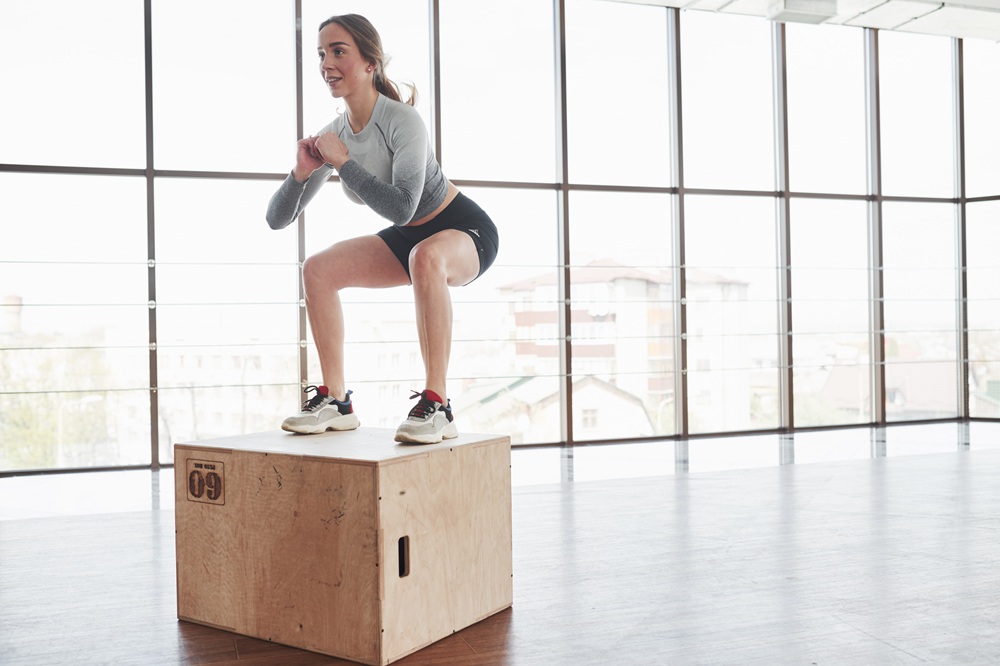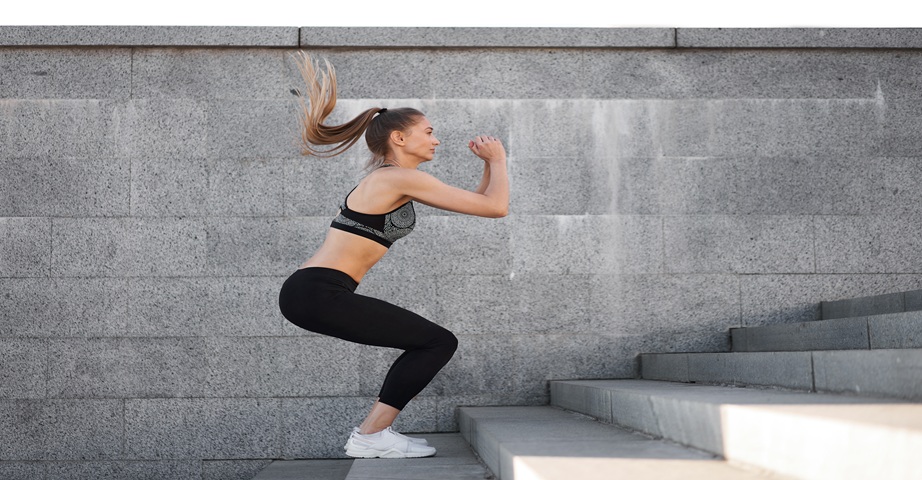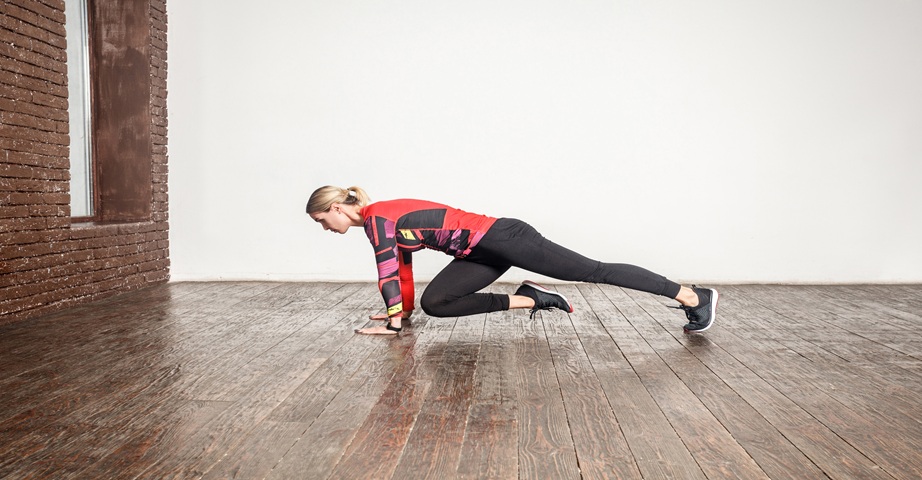Plyometric training - what is it? The best plyometric exercises

Plyometric training is a dynamic form of physical activity, focusing primarily on the development of speed and explosive strength. It is a jumping effort, focused on the use of rapid muscle contractions, which involves many muscle groups at the same time. It is a training method willingly used by speed and endurance athletes, which is also practised by team sports players. What is plyometry? What are the most popular examples of plyometric exercises? What does a plyometric exercise plan look like? Is plyometric training suitable for everyone?
Summary
- Plyometry - what is it?
- Advantages and disadvantages of plyometric training
- Plyometric training - who is it recommended for?
- Plyometry - contraindications
- Plyometric training at home and in the gym - the rules
- Plyometric exercises
- Plyometrics - effects. What do plyometric exercises give?
- Example plyometric training - training plan
- Dietary supplements helpful in plyometric training
Plyometry - what is it?
Plyometric training, also referred to as plyo or jump training, is a form of exercise that is based on the natural ability of muscles to contract and stretch, thus based on the concentric and eccentric phase.
This training is also known as SSC (Stretch-Shortening Cycle), which allows you to accumulate and use potential energy, which then allows you to generate a lot of strength in a short time, promoting the development of dynamic strength, or power. It is a course of action that can contribute to increasing the reactivity of the nervous system in relation to muscles, finding purpose in many different sports.
What is plyometric training?
Exercise plyometry is a training method using specific movement mechanics, which results from the fact that muscles during movement pass through two phases. During eccentric contraction, muscle stretching, which promotes the storage of mechanical energy, which is then used to generate strength and speed during concentric contraction, responsible for shortening the muscle.
The validity of plyometric training is based on the ability of the muscle to stretch and contract, and the more the muscle is stretched, the greater is the power potential, which is the result of tensioning structures such as fascia, tendons or muscle sheath. This phenomenon promotes the performance of dynamic movements and leads to the effective use of muscle strength. At the same time, constant nerve stimulation accelerates the response of muscles to stretching, which can reduce the risk of injuries during sudden changes in directions or intense jumps.
Recommended dietary supplements
Advantages and disadvantages of plyometric training
Plyometry at home and the plyometric exercises performed at the gym have both advantages and disadvantages. It is a training method conducive to increasing strength, jumping and speed, which can also lead to improving the body's performance during sports that require explosive strength, as well as during jumps, sprinting runs or throws. In addition, the benefits of plyometric training also include strengthening tendons and ligaments and improving efficiency, which is the result of engaging the respiratory and cardiovascular systems during exercise. Physical activity of this type can also cause an increase in motor coordination, as well as control over your own body, positively affecting, among others, the nervous system and reaction speed, which results from the fact that plyometric training engages many muscle groups at the same time.
Despite the numerous advantages, plyometric exercises also have some disadvantages. Intensive training of this type can be a burden on the joints, negatively affecting, among others, the knees, hips or ankle joints. In addition, plyometry has a high risk of injury, which results, among others, from the intensity of exercise or the need to master the right technique before starting physical exercise. Due to the fact that jumping exercises overload the locomotor system, joints and tendons are exposed to damage, and the high level of difficulty of plyometric techniques causes that novice athletes may have a problem with their proper performance, which may discourage enthusiasts of physical activity to practise this type of effort.
Plyometric training - who is it recommended for?
Plyometric training can be an excellent solution among experienced athletes, in particular among athletes practising martial arts and skiing, weightlifting or athletics. In addition, the training method can be helpful among runners, as well as among supporters of team games such as football, volleyball or basketball, among which quick reaction time is crucial.
Due to the fact that plyometric exercises can be adapted to the needs and capabilities of different people, the plyometry can also be a support among seniors and people after injuries as a rehabilitation method used under the supervision of a qualified physiotherapist. In addition, the benefits of practising plyometric training can also be observed by amateurs and people training recreationally, but it is extremely important to properly prepare the locomotor system to amortization significant loads. Beginner athletes who are not prepared for the load on the musculoskeletal system can lead to serious injury instead of strengthening the muscles and joints.
Plyometric exercises for footballers
Plyometry can be helpful among professional athletes practising team sports, in particular among footballers, being an important element of football training. This is due to the fact that the plyometric training allows developing motor skills, such as agility, speed or flexibility, which are extremely important when playing football.
Regular plyometric exercises can improve the explosiveness of players, which is crucial on the field. In addition, this type of activity promotes the increase in the performance of the athlete, improving not only muscle power, but also motor coordination and nerve activation. Football players which train the plyometry are able to react quickly to a changing situation on the field, while better controlling the ball and opponents. Practising plyometric exercises during football training can also increase the effectiveness of attacks during a match, while minimizing the risk of injury by strengthening joints, tendons and ligaments.
Plyometry - contraindications
Plyometric training is a demanding method of exercise that will not work among all players. As we have already mentioned, plyometrics should be abandoned by beginners who are not properly prepared for significant loads. In addition, plyometric exercises may not be a good solution among consumers after recent injuries, as well as among people struggling with diseases of the joints and musculoskeletal system. People struggling with obesity should also give up this type of activity, and without consulting a doctor, the plyometric training should not be performed by consumers with respiratory or cardiovascular diseases.

Plyometric training at home and in the gym - the rules
To safely start plyometric training, it is worth starting with simple activities, such as jumping rope, taking care of the gradual introduction of exercises to the training program, which will give the body time to adapt to a new type of loads. In addition, attention should be paid to the correct technique of performing plyometric exercises, because their improper practise can lead to overloads and injuries. The key aspect seems to be mastering the rules of jumping and landing - the leap and jump should take place at slightly bent ankle and knee joints, while stable and symmetrical positioning of the feet.
Due to the fact that the plyometric training is a heavy burden for the body, it is extremely important to control the intensity of activities and to adjust the practised exercises and the number of repetitions to the individual abilities of the player. What is more, an important role is played by the appropriate selection of shoes and the surface on which the athlete exercises physical effort. Plyometrics shoes should provide adequate amortization and stability, while the surface should well absorb shock waves. Therefore, it is not recommended to perform plyometric training on concrete or asphalt, but to use grass, training mats or special sports surfaces for this purpose.
Before you start practising plyometric activities, you need to perform an appropriate warm-up, which will prepare the muscles for increased physical exertion. After the training, it is important to stretch the whole body, which can reduce the risk of injury and delayed muscle pain DOMS. In addition, you should take care of the right recovery time between efforts - the obtained data indicate that plyometric exercises can be practised 3 times a week, while maintaining a minimum of 24 hours break between workouts.
Plyometric exercises
Plyometric exercises can affect both the contractility of the lower and upper muscle parts. In addition, jumping activities can be adapted to the individual needs of the athlete, adjusting the practised exercises to the level of advancement of the athlete, as well as to his preferences and training goals. The activities most often practised during the plyometric training include exercises such as:
- skip A, that is, running in a place with alternating lifting of the knees,
- jumping jack,
- forward jumps and backward jumps,
- box jump,
- plyometric push-ups, consisting in breaking out with hands from the ground, which additionally engages triceps and muscles of the arms and chest,
- burpees,
- jumping rope,
- jumps with knee pull to the chest,
- throw a medicine ball in front of you, behind your head or behind,
- dynamic squats with a jump up,
- single-leg jumps,
- bench jumps,
- leapfrog,
- push-ups with clap,
- plyometric lunges.
Plyometrics - effects. What do plyometric exercises give?
Plyometric training is a versatile exercise method that can provide multidimensional effects. Plyometry leads to a noticeable increase in explosive strength, which allows generating more power in a shorter time, favouring better results during jumps, sprints or activities requiring rapid change of direction. Additionally, adding plyometrics to a training program can:
- increase muscle endurance,
- improve coordination and balance,
- strengthen joints, tendons and ligaments,
- improve speed,
- strengthen the muscles of the lower extremities,
- improve overall physical condition,
- favourably affect the appearance and slenderness of the figure,
- help burn calories and reduce excess body fat,
- improve the well-being,
- reduce reaction time,
- increase the dynamics of movements and flexibility of the body.

Example plyometric training - training plan
An example of plyometric training is physical activity, which should start with a 15-minute warm-up of the whole body. As part of the body warming exercises, you can do a trot in place, skip A and skip C, as well as squats, leg swings or jumping jacks.
Next, you should take care of the safety of the activities performed, paying attention, among others, to the surface on which the exercises will be performed, and then go to the proper training. During the exercise of a jumping nature, the number of repetitions and series of exercises should be adjusted to individual possibilities. Beginner supporters of this type of activity can use 3-4 series during training, taking into account 5-6 repetitions of each exercise. Thus, the plyometric training plan can be based on activities such as:
- single-leg jumps,
- burpees,
- box jumps,
- throw the medicine ball in front of you,
- plyometric push-ups.
During the exercises, you should focus on the correct technique of their performance, practising activities with maximum precision. On the other hand, after the end of practising jumping exercises, you should spend about 15 minutes on stretching, that is, stretching the whole body, which will allow you to calm the body, restore even breathing and heart function, and also reduce the likelihood of developing soreness.
Dietary supplements helpful in plyometric training
Among athletes who regularly practise plyometric training, a good solution can be dietary supplements that can have a positive impact on the performance and endurance of the consumer, supporting the effectiveness of exercises. Thus, proponents of jumping activities should pay attention to dietary supplements containing compounds, such as:
- Caffeine, which may delay fatigue and tiredness, providing the energy necessary during exercise, while also supporting concentration and focus during training - a preparation such as OstroVit Caffeine powder 200 g with a natural flavour, which is a concentrated source of the desired substance may be helpful;
- Carbohydrates, which can provide the supply of energy necessary to perform increased work by the body - support may be a dietary supplement, such as OstroVit Carbo 3000 g of cherry flavour, which provides the supply of carbohydrates in the form of easily digestible maltodextrin and dextrose, and at the same time is enriched with other, valuable compounds;
- Creatine, which can increase physical performance during short but very intense physical exercise, while supporting muscle strength and endurance - a good solution may be a product such as OstroVit Creatine Monohydrate 1000 g of mango flavour, which is a treasure trove of creatine and does not provide the athlete's body with unnecessary ingredients.
Valuable support in the case of plyometric training may also be joint supplements, such as OstroVit Flex Regen 120 tablets, which provide the body with chondroitin, MSM, collagen or glucosamine, thus supporting the optimal condition of the locomotor system.

